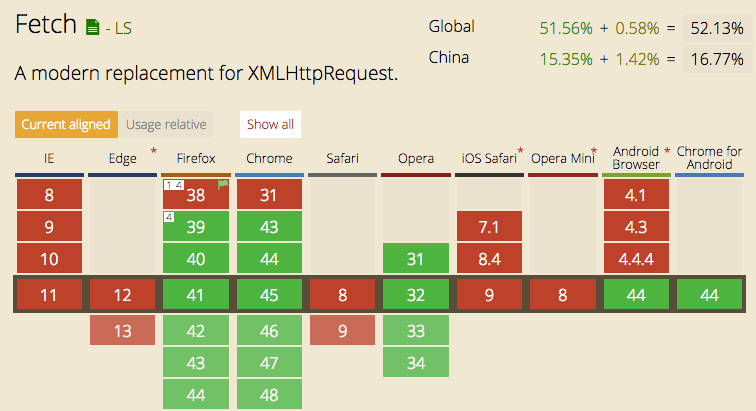XMLHttpRequest
XMLHttpRequest是最早出现的与服务器交换数据的方案,有了XMLHttpRequest,开发者终于可以在不重新加载页面的情况下更新网页,可以在页面加载后请求接受以及发送数据。而所有浏览器均可以获取XMLHttpRequest对象:
1
| var xhr = new XMLHttpRequest();
|
但是XMLHttpRequest是个比较粗燥的底层对象,各个浏览器对其的创建方法也不同,以下是兼容方法:
1
2
3
4
5
6
7
8
9
10
11
12
13
14
| var xhr;
if (window.XMLHttpRequest) {
xhr = new XMLHttpRequest();
} else if (window.ActiveXObject) {
try {
xhr = new ActiveXObject('Msxml2.XMLHTTP');
} catch (e) {
try {
xhr = new ActiveXObject('Microsoft.XMLHTTP');
} catch (e) {}
}
}
|
使用XMLHttpRequest发起一个get请求
1
2
|
xhr.open("GET","test1.txt",true);xhr.send();
|
完整的post请求代码如下:
1
2
3
4
5
6
7
8
9
10
11
12
13
14
15
16
17
18
19
20
21
22
23
24
25
26
27
28
29
30
| var xhr;
if (window.XMLHttpRequest) {
xhr = new XMLHttpRequest();
} else if (window.ActiveXObject) {
try {
xhr = new ActiveXObject('Msxml2.XMLHTTP');
} catch (e) {
try {
xhr = new ActiveXObject('Microsoft.XMLHTTP');
} catch (e) {
}
}}if (xhr) {
xhr.onreadystatechange = onReadyStateChange;
xhr.open('POST', '/api', true);
xhr.setRequestHeader('Content-Type', 'application/x-www-form-urlencoded');
xhr.send('username=admin&password=root');}
function onReadyStateChange() {
if (xhr.readyState === 4 &&xhr.status === 200) {
console.log('执行成功');
} else {
console.log('执行出错');
}
}
|
Jquery Ajax
说到Jquery,这是一个时代,几乎统治了前端10年有余,彻底解决了UI层与数据层交互的问题,直到三大框架(Angular/React/Vue)的出现,前端进入MVVM浪潮。而Ajax将XHR进行封装,让开发者可以更加便捷方便进行使用。
1
2
3
4
5
6
7
8
9
10
11
12
13
14
| $.ajax({
type: 'POST',
url: url,
data: data,
dataType: dataType,
success: function () {},
error: function () {}});
$.get(url,function(){});
$.post(url,body,function(){});
$.getJSON(url,function(){});
|
优点:
- 对原生XHR的封装
- 针对MVC的编程
- 完美的兼容性
- 支持jsonp
缺点:
- 不符合MVVM
- 异步模型不够现代,不支持链式,代码可读性差
- 整个Jquery太大,引入成本过高
Fetch
fetch其实是一个新世界,脱离的XHR,完全是基于Promise的异步处理机制,使用起来会比起ajax更加简单。
使用fetch的代码会相比xhr来说更具有条理性
1
2
3
4
5
6
| fetch(url).then(function(response) {
return response.json();}).then(function(data) {
console.log(data);
}).catch(function(e) {
console.log("Oops, error");
});
|
在使用ES6的箭头函数后
1
2
3
| fetch(url).then(response => response.json())
.then(data => console.log(data))
.catch(e => console.log("Oops, error", e))
|
优点:
- 更加底层,提供的API丰富(request, response)
- 语法简单,脱离了XHR,基于ES新的Promise设计
看到以上,或许你会觉得fetch真的很美好,但是请了解,fetch本身是一个 low-level 的 API,它注定不会像你习惯的 $.ajax 或是 axios 等库帮你封装各种各样的功能或实现。
所以它是存在一定的缺点:
- 兼容性比较凄惨,低级别浏览器均不支持,需要实现fetch的polyfill了。思路其实很简单,就是判断浏览器是否支持原生的fetch,不支持的话,就仍然使用XMLHttpRequest的方式实现,同时结合Promise来进行封装。常见的polyfill就有:es6-promise,babel-polyfill,fetch-ie8等

- 不支持jsonp,可以引入fetch-jsonp `javascript //安装 npm install fetch-jsonp –save-dev
1
2
3
4
5
6
7
8
9
10
11
|
fetchJsonp(url, {
timeout: 3000,
jsonpCallback: 'callback'
})
.then(function(response) {
console.log(response.json());
})
.catch(function(e) {
console.log(e)
});
|
- 没有拦截器,需要额外再封装一层或者fetch-interceptor- 默认不带cookie,需要添加配置
1
2
3
| javascriptfetch(url,{
credentials: 'include'
});
|
可以用Promise.race()实现,Promise.race(iterable) 方法返回一个Promise对象,只要 iterable 中任意一个Promise 被 resolve 或者 reject 后,外部的Promise 就会以相同的值被 resolve 或者 reject。
fetch中的Response.body 中实现了getReader()方法用于读取原始字节流, 该字节流可以循环读取。参考:
https://stackoverflow.com/questions/35711724/upload-progress-indicators-for-fetch
https://jakearchibald.com/2016/streams-ftw/
Axios
axios也是比较新的网络请求的类库,并且被尤雨溪尤大推荐,已成为VUE的网络请求标配,也是十分的火爆。它本身也是对原生XHR的封装。
- 支持node,创建http请求
- 支持Promise API
- 客户端防止CSRF:每个请求带一个cookie拿到的key
- 拦截请求和响应
- 可取消请求
兼容性上虽然axios本质上也是对原生XHR的封装,但是它也依赖原生ES6 Promise的实现,和fetch一样需要polyfill的兼容。

安装
基本使用如下:
1
2
3
4
5
6
7
8
9
10
11
12
13
14
15
16
17
18
19
20
21
22
23
24
25
26
27
28
| axios({
method: 'GET',
url: url,})
.then(res => {
console.log(res)
})
.catch(err => {
console.log(err)
})
axios.get(url)
.then(function (response) {
console.log(response);
})
.catch(function (error) {
console.log(error);
});
axios.post(‘/user’, {
name: 'Jerry',
lastName: 'Liang'
})
.then(function (response) {
console.log(response);
})
.catch(function (error) {
console.log(error);
});
|
特殊场景的处理
在开发过程中,经常会遇到比较尴尬的场景就是多请求的串行与并发,并发比较容易解决,不存在回调地狱,但是代码可读性就会容易变得很渣,而串行问题对于前端是绝望的,最好的办法是后端来做合并,如果后端不做这块的处理,前端就必须来面对回调地狱。
多请求串行
1
2
3
4
5
6
7
8
9
10
11
12
13
14
15
16
17
18
19
20
21
22
23
24
|
$.ajax({
url: '',
data: '',
success: function (data) {
$.ajax({
url: '',
data: '',
success: function (data
) {
$.ajax({
})
}
})
}})
axios.get(url).then(res => {
return axios.get(url,{
{name:result.name}
});
}).then(res => {
});
|
多请求并行
1
2
3
4
5
6
7
8
9
10
11
12
13
14
15
16
17
18
19
20
21
22
23
24
25
26
27
28
29
30
31
32
33
34
35
36
37
|
var num = 0;
function all(){
num++;
if(n>=3)console.log('三个请求全部完成');
}
$.ajax({
url: '',
data: '',
success: function (data) {
console.log("ajax请求1 完成");
all();
}})
$.ajax({
url: '',
data: '',
success: function (data) {
console.log("ajax请求2 完成");
all();
}})
$.ajax({
url: '',
data: '',
success: function (data) {
console.log("ajax请求3 完成");
all();
}})
function getInfo() {
return axios.get(url);
}function getUser() {
return axios.get(url);
}axios.all([getInfo(),
getUser()])
.then(axios.spread(function (info, user) {
}));
|


评论加载中